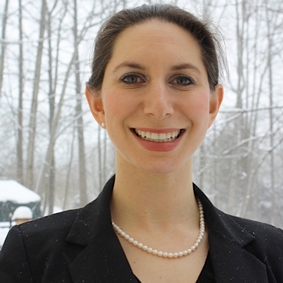Knauss legislative fellowships in Congress help build careers — and they're fun and educational. See our video and fact sheet for details.
Tammy Newcomer Johnson

Fellowship Institution:
NOAA National Sea Grant OfficeStart Year:
2014Tammy Newcomer Johnson spent her fellowship year in the National Sea Grant Office at NOAA. She served as a national resource specialist.
Originally from Maryland, Newcomer Johnson has dedicated her career to exploring and understanding how humans can live sustainably within their environment. As a doctoral student in the Marine Estuarine Environmental Science (MEES) program at the University of Maryland, College Park, she explores the impacts of urbanization on the ecology and water quality of the Chesapeake Bay. Her research focuses on the capacity of stream restoration and stormwater management projects to reduce excess nitrogen flowing from urban areas to the estuary.
Before beginning graduate school, she worked on a number of research projects through a program called the Baltimore Ecosystem Study. These included efforts to map the occurrence of flash floods in the city. She also served as a fellow at the National Science Foundation and collaborated with students and teachers at the K-12 level to design hands-on environmental science lessons revolving around water, biodiversity, and carbon.
Newcomer Johnson has also spent many years volunteering with Habitat for Humanity to construct affordable housing for underserved communities in Maryland and Florida. She’s now in the midst of renovating her own 1947 bungalow in Reisterstown, Maryland, with her husband.
Call for Symposium Presenters and Authors
The Chesapeake Rising: Innovative Law and Policy Solutions for Climate Adaptation in Coastal Communities symposium will explore key legal and policy considerations that affect climate adaptation strategies. It provides a unique opportunity for upper-level law students and early-career lawyers to present and publish their legal scholarship.
Program Announcements
-
-
Maryland Sea Grant has program development funds for start-up efforts, graduate student research, or strategic support for emerging areas of research. Apply here.
News and Blogs
Video Gallery
Sea Grant Film Explores a Diminishing Smithville
Smithville is a community on Maryland’s Eastern Shore, on the edge of the Blackwater National Wildlife Refuge. A century ago, Smithville had more than 100 residents. Today, it has four, in two homes: an elderly couple, and one elderly woman and her son, who cares for her.
Featured Fellow
Featured Research Project
Developing a habitat model for mysids, an important link in Chesapeake Bay food webs
Mysids are important mesozooplankton prey for many species of fish in Chesapeake Bay and are an important link in transferring energy from lower to upper trophic levels. Mysids also serve as biological vectors for benthic-pelagic coupling due to their diel vertical migration and omnivorous prey-switching behavior, which makes mysids important regulators of food web architecture. Despite their central role in coastal food webs, surprisingly little is known about mysid ecology and dynamics in Chesapeake Bay.
The Blue Crab: Callinectes Sapidus
An essential resource for researchers, students, and managers. Get your copy today!


©2025 Maryland Sea Grant. All rights reserved.
5825 University Research Court, Suite 1350 | College Park, MD 20740
Phone: (301) 405-7500 | Fax: (301) 314-5780 | Contact Us



